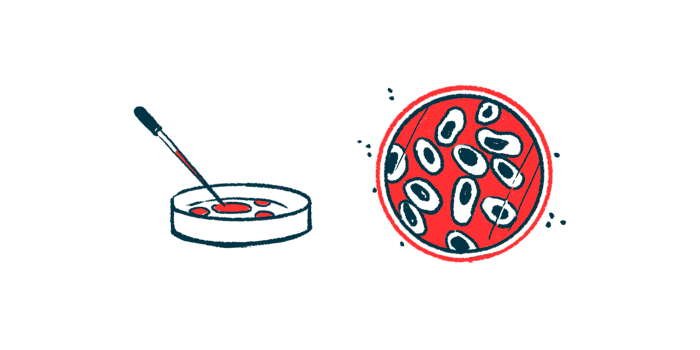How Parts of Trikafta Help Enable CFTR Protein Evident in Clusters
Written by |

Clustering of the CFTR protein in lipid (fat)-rich platforms on the cell membrane, which can occur when the cell is under stress and increases the number of working CFTR proteins, is disrupted by cystic fibrosis (CF)-causing mutations, a recent study shows.
CFTR modulators that are part of Trikafta were found to restore CFTR trafficking, clustering, and cell dynamics through “a previously unrecognized mechanism of action,” its researchers wrote.
“The success of these therapeutics provides proof-of-principle for the development of therapeutics for other protein trafficking diseases,” they noted.
The study, “Lipid-driven CFTR clustering is impaired in CF and restored by corrector drugs,” was published in the Journal of Cell Science.
CF is caused by mutations in the CFTR gene, which provides instructions to produce the CFTR protein — a protein channel that controls the flow of chloride ions and water through cells. More than 2,000 mutations in the CFTR gene have been identified, two of which are F508del, the most common CF-causing mutation, and S13F.
Some mutations result in abnormal CFTR structure, early degradation, and problems with trafficking of CFTR from the endoplasmic reticulum — where proteins are made — to the cell membrane.
CFTR modulators are designed to improve the CFTR protein’s functioning in people with specific mutations. Among them — correctors, such as elexacaftor (VX-445), lumacaftor (VX-809) and tezacaftor (VX-661) — work to ensure the correct three-dimensional folding of CFTR so that it can reach the cell surface and function appropriately.
Stabilizing the CFTR protein at the cell surface with treatment is an important target in CF research. Strategies successful for CFTR may be applied to other diseases caused by protein misfolding, the scientists said.
In bronchial epithelial cells, which line the airways, CFTR can be found in clusters or spread out under normal conditions. Clustered CFTR move in so-called lipid rafts that merge to form large platforms in response to stress.
A team of researchers in Canada and Australia explored the mechanism about how CFTR clusters and is recruited into lipid platforms on the cell surface.
Using cultured bronchial epithelial cells, CFTR clusters were induced into forming large platforms with thapsigargin, a compound that increases calcium levels inside cells. These platforms resemble those formed during infection and cell stress, the scientists noted. They verified that CFTR clusters associate with lipid rafts that contain cholesterol and sphingomyelin, two cell membrane components.
The end section of the CFTR protein — called the C-terminal motif — is known to interact with certain structures on other proteins (PDZ domains) impacting CFTR trafficking, recycling, and removal from the cell surface. To determine whether PDZ domains control CFTR clustering in lipid rafts, the researchers generated a mutant CFTR without the C-terminal motif. Results showed that this mutant protein formed normal clusters and was incorporated into platforms after stimulation with thapsigargin.
Additional experiments showed that CFTR clustering or incorporation into platforms was not dependent on filamin A or actin — two structural proteins within cells — or by palmitoylation, a common modification for targeting proteins to lipid rafts.
Low concentrations of detergent induced CFTR clustering, an indicaton that this process is lipid-driven.
“Together with our previous results manipulating cholesterol levels these findings indicate that CFTR clustering may be driven by CFTR-lipid rather than CFTR-protein interactions,” the researchers wrote.
Next, the team produced genetically engineered cells with the F508del mutation. Only a few clusters and no platforms were observed in these cells. Treatment with elexacaftor combined with tezacaftor, both components of Vertex Pharmaceuticals‘ Trikafta, restored CFTR clustering and incorporation into platforms in cells with the F508del mutation.
A similar lack of CFTR clusters and incorporation into platforms was observed in cells with the S13F mutation, which was also reversed with elexacaftor and tezacaftor.
“In summary, CFTR clustering occurs through a mechanism that depends mainly on interactions with lipids rather than other proteins. Clustering enables CFTR incorporation into [lipid] platforms but is prevented by some CF-causing mutations,” the investigators concluded.
“Potent correctors of CFTR misfolding such as those in Trikafta restore CFTR clustering and dynamics at the cell membrane, a previously unrecognized mechanism of action that may be relevant to other protein folding diseases,” they added.







